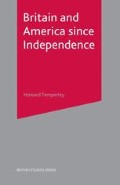Abstract
Britain emerged from its long-drawn-out struggles with France reassured in its view of itself as the world’s leading nation. Fears that the loss of her American colonies presaged the ending of its status as a great power had by 1815 long since evaporated. Unexpected and humiliating though that event had been, its effects were soon offset by the acquisition of a vast new empire in India. The population of the rebellious colonies at the time of the War of Independence had been a mere 4 million, whereas that of India was not much short of 150 million. The United States might be large in a geographical sense but its towns, cities and other human constructs were diminutive by comparison with those of India. Almost everything about the United States had a provisional, impermanent look about it, as if it was either in the process of construction or about to be pulled down. Early nineteenth-century drawings of New York, Philadelphia and other cities show a scattering of dockyards, warehouses, shops, churches and dwellings, built mostly of wood. Beyond the narrow coastal strip of settlement, seldom more than 150 miles wide, stretched thousands of miles of wilderness. America was raw and new, a land of wide-open spaces, its potential yet to be realised. India, by contrast, was an old civilisation, a continent swarming with people, made up of peasant farms, marble temples and busy cities. Nowhere in North America was there anything to compare with the gigantic fortresses of the Mogul Emperors, or, in terms of wealth, with its princely rulers and their retinues.
Preview
Unable to display preview. Download preview PDF.
Notes
Pierre Berton, Klondike: The Last Great Gold Rush (Toronto, 1972). Also revealing with regard to the law and order issue is Paul F. Sharp, The Whoop-Up Country: The Canadian-American West, 1865–1885 (Helena, Historical Society of Montana, 1955).
Quoted in William Brock, ‘The Image of England and American Nationalism’, Journal of American Studies, 5 (December 1971), 239.
The text of the Address is in B. B. Sideman and L. Friedman, eds., Europe Looks at the Civil War (New York 1960), pp. 166–8; Lincoln’s characteristically gracious reply is in Roy P. Basler, ed., The Collected Works of Abraham Lincoln (8 vols., New Brunswick, NJ, 1953–55), VI, 63–5.
Quoted in Allen, p. 484; see also E. D. Adams, Great Britain and the American Civil War (2 vols., London, 1925), II, 49.
Copyright information
© 2002 Howard Temperley
About this chapter
Cite this chapter
Temperley, H. (2002). Political Rivalries and Cultural Affinities: 1815–1865. In: Britain and America since Independence. British Studies Series. Palgrave, London. https://doi.org/10.1007/978-1-349-87971-7_4
Download citation
DOI: https://doi.org/10.1007/978-1-349-87971-7_4
Publisher Name: Palgrave, London
Print ISBN: 978-0-333-67236-5
Online ISBN: 978-1-349-87971-7
eBook Packages: Palgrave History CollectionHistory (R0)

